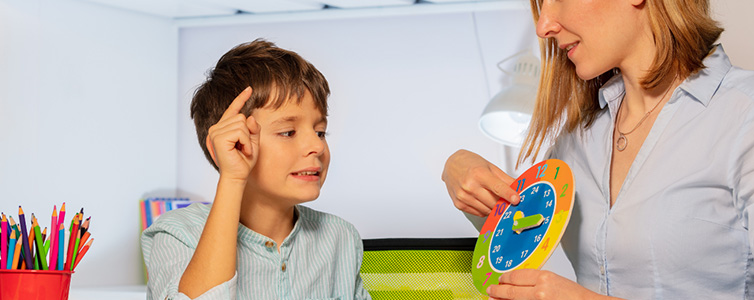What is Mild Autism?
The early version of the Diagnostic and Statistical Manual of Mental Health (DSM-IV TR), included Asperger's Syndrome which was viewed as a form of mild autism.
Today, Asperger's Syndrome no longer remains a diagnosis in the DSM-5 TR, as clinicians and researchers believe that the symptoms of autism and Asperger's syndrome became difficult to distinguish for psychologists and which diagnosis would be provided started to depend on who was performing the assessment.
Due to the severity of their symptoms, most of the mildly autistic children do not get diagnosed until they are adults.
However, certain traits distinguish these autistic children from others. The term “Being on the Spectrum” is usually used to refer to mildly autistic people. Every child on the spectrum might show different traits and behaviours.
It becomes important for caregivers and parents to pay close attention to their child’s behaviour as well as have useful knowledge about the traits experienced and exhibited by such children.
This makes it easier for an early intervention to be provided and for the diagnosis to remain unnoticed.
Characteristics of Mild Autism in Children
Autistic people regardless of the severity of their disturbance are given the diagnosis of Autism Spectrum Disorder (ASD).
The classification of the severity of the symptoms is indicated by levels. Each level indicates the amount of support an autistic person would need. Mild Autism falls under level 1 and is the one which requires the least amount of support.
Autism spectrum disorder is characterised by difficulties in social communication, patterns of repetitive behaviour, difficulty in adapting to change as well as hypersensitivity to sensory experiences as well as lower IQ levels.
Concerning this, mild autistic children do have a higher IQ level and fair good in academics. However, they do display challenges in social relationships as well as sensory issues.
The types and amount of care and support needed for mildly autistic children will differ from person to person. A generalised list of support needed included:
- Helping the child to cope and reduce their anxiety
- Teaching the child to understand non-verbal communication
- Helping the child control their emotions and expressions.
- Enhancing their communication skills, especially skills that aid the child to hold communication and talk back and forth.
Causes of Mild Autism in Children
There is no single cause that contributes solely to autism. Autism Spectrum Disorder is complex, varying not only in severity but also in its symptoms. Various factors like genetics and environmental factors, contribute to this disorder.
Research evidence suggests that several genes are related to Autism Spectrum Disorder. Genetic mutation may increase the risk of autism.
These might be inherited or de novo. Genetic disorders like Fragile X syndrome are also associated with ASD. Changes in neural connectivity and brain cells can also impact the severity of the symptoms.
Symptoms of Mild Autism in Children
The neurodivergent traits in children with mild autism are not very noticeable and are often very easy to overlook. This is because these children exhibit many neurotypical traits and the neurodivergent traits are so slight, that they are mistaken merely as personality differences.
Sometimes parents and caregivers do notice “atypical” behavioural patterns, however, these behavioural patterns do not warrant an immediate diagnosis.
According to the Centers for Disease Control and Prevention (CDC), the symptoms of mild autism in children include the following:
- Echolalia: The children display meaningless repetition of words.
- Fixation: The children become attached to some form of a fixed routine. They become fixated on their interests, ideas or concepts. They might have a fixed and specific way of doing things and carrying out a task. This brings out a feeling of security amongst them and any change in routine is difficult to adapt to and leads to discomfort.
- Eye Contact: Children with mild autism usually avoid eye contact especially while communicating. This makes it difficult to engage them in conversations.
- Social Interaction: Some mildly autistic children prefer isolation over social interaction. Engaging in social situations is usually very upsetting for them, as they might be unable to comprehend societal rules and also take into account the perspective of others.
They might also avoid physical touch like hugging their peers or family members or cuddling as a form of affection. They might not understand the term “talking about your feelings.”
Difficulties in the Diagnosis of Mild Autism in Children
The diagnosis of autism is usually provided around 2 years of age. However, mildly autistic children receive their diagnosis as late as 6 years of age and sometimes not until adulthood. Several factors play a role in this.
Gender
Gender has been found to interact with the recognition and diagnosis of autism. Studies show that girls who are autistic, have autistic traits like “shy” and “withdrawn” but these traits are often seen as something expected or seen in girls.
A diagnosis becomes difficult as these traits are deemed typical of a girl.
Compared to boys, autistic girls display less overt repetitive behaviour. This leads to a delay in their diagnosis compared to boys.
Masking or Camouflage
Autistic people are often made to believe that to fit in, they need to suppress their neurodivergent traits and present neurotypical patterns of behaviour.
Therefore, masking, that is, suppressing their pattern of thoughts and behaviour, can be considered a social survival strategy.
Masking includes behaviours like
- Forcing oneself to make eye contact
- Having a set of rehearsed responses that can be used in a conversation
- Learning to imitate facial expressions
- Trying to hide one’s stimming
- Trying to overcome or push through the sensory overload
Since mildly autistic people might be able to mask more effortlessly than others, it leads to difficulties in diagnosis.
Masking does have negative consequences and is considered draining, not only physically but also mentally.
Misdiagnosis
Misdiagnosis also becomes pretty common amongst mildly autistic people. However, this is far more common among autistic adults than children.
With proper parental observation of a child’s behaviour and recognising early symptoms, a misdiagnosis can be avoided.
What is the Assessment Process of Mild Autism?
Standardised assessment plans like the Autism Diagnostic Observation Schedule (ADOS) and the Autism Diagnostic Interview-Revised (ADI-R) are often used to provide an in-depth diagnosis.
Moreover, the diagnostic process of autism includes various other steps for a foolproof and in-depth review of a person’s symptoms.
Parental/Caregiver Interview: The information provided by parents and caregivers about the child’s behaviour, behavioural milestones, the history of the child’s development as well as other concerns related to the way a child reacts and interacts with the environment helps in the process of diagnosis.
Observation: Simply making a diagnosis based on the observation made by parents and caregivers is not enough. It becomes important for the professional to assess the child’s function in various settings and when exposed to different types of stimuli.
Standardised Assessments: The Autism Spectrum Screening Questionnaire, Autism Diagnostic Observation Schedule (ADOS) and the Autism Diagnostic Interview-Revised (ADI-R) are all valid and reliable screening tools that are used by professionals.
What are the treatments for mild autism?
Seeking timely assistance through various evidence-based psychological intervention programmes can help improve social communication.
It’s crucial that after an individual is diagnosed with autism, they, as well as, their caregivers/loved ones, get the appropriate help, care, and support that will cater for their unique needs as they grow and change.
Speech Therapy
Children with autism might have a deficit in using and understanding language in a social context. To overcome this, speech therapy as an early intervention strategy has been proven to be beneficial.
It is important to note that the first five years of a child are very critical for brain development. Therefore, providing an early intervention can prove to be highly beneficial.
A speech therapist, also known as a speech-language pathologist (SLP) might play a major beneficial role in helping a child develop communication and interaction skills.
Speech therapists also might help the children with prosody. Prosody refers to the melodic tone of voice that keeps changing as one converses. Autism can lead to people having a flattened prosody, which is often mistaken as having no emotions.
A speech therapist helps in the development of vocal skills. Some autistic children might be unable to use grammar properly, such as using third person to refer to themselves.
Speech therapists work with these children to help improve their grammar skills. Speech therapy not only helps in the development of nonverbal and verbal communication skills but also alternative communication skills with the use of pictures or technology.
A speech therapist would be capable of identifying alternative augmentative communication (AAC), such as the picture exchange communication system (PECS), sign language, speech output devices, etc.
Play Therapy
Play Therapy is often used for children with autism who display repetitive patterns of behaviour, are more likely to stay alone and stick to only a limited number of activities that don't allow them to learn and grow as they are unable to explore their abilities and potential.
Play therapy for autism is based on the idea that play becomes a way for children to express themselves in a safe and non-judgmental environment.
Through play therapy, emotions and feelings can be communicated in a non-verbal way, and a child can also learn to communicate and develop social skills.
It's worth noting that play therapy becomes beneficial not only for the child but also for their caregivers and parents as they can understand how their child interacts and communicates.
This facilitates an understanding of the child’s needs and forms a closer bond between the parent/caregiver and the child.
Group play might also be introduced at a later stage of the therapy, as it may help develop social skills and communication.
The Floortime Approach and the Play Project are some of the approaches that make use of play to aid in the learning and development of children with autism.
Occupational Therapy
Occupational therapy aims to improve autistic children’s motor skills as well as the sensory challenges that they face.
Modified Checklist for Autism in Toddlers (M-CHAT), School Function Assessment (SFA), and Assessment of Life Habits (Life - H) Children, are some of the renowned tests used by occupational therapists to assess autistic children and create an optional intervention programme for them.
Occupational Therapists observe children in their natural habitat, to understand the needs of the child based on how the child manages their daily life and tasks.
Applied Behaviour Analysis (ABA) Therapy
Applied Behaviour Analysis or ABA, as the name suggests, is a strategy focused on identifying and modifying behaviour. Commonly used for children with autism who are under the age of five years old.
Simply put, applied behaviour analysis (ABA) is based on the theory of behaviour. Therefore, it rewards positive behaviour, reinforcing it to occur again and ignores negative behaviour, decreasing the likelihood of it happening again.
Moreover, ABA also pays attention to the triggers that lead a child with autism to behave the way they do, as well as the consequences of a child's behaviour.
This helps one to understand whether certain modifications can be made in the child's environment that will lead to a positive change in the child's behaviour.
Is Mild Autism curable?
There is no cure for autism spectrum conditions, and no single treatment works for everyone. Treatment is to help your kid learn, develop, and behave.
Early treatment, throughout the preschool years, can help your kid develop important social, communicative, functional, and behavioral skills.
The variety of home-based and school-based therapies for autism spectrum conditions can be bewildering, and your child's requirements may evolve over time. Your healthcare provider can provide recommendations and direct you to services in your region.


